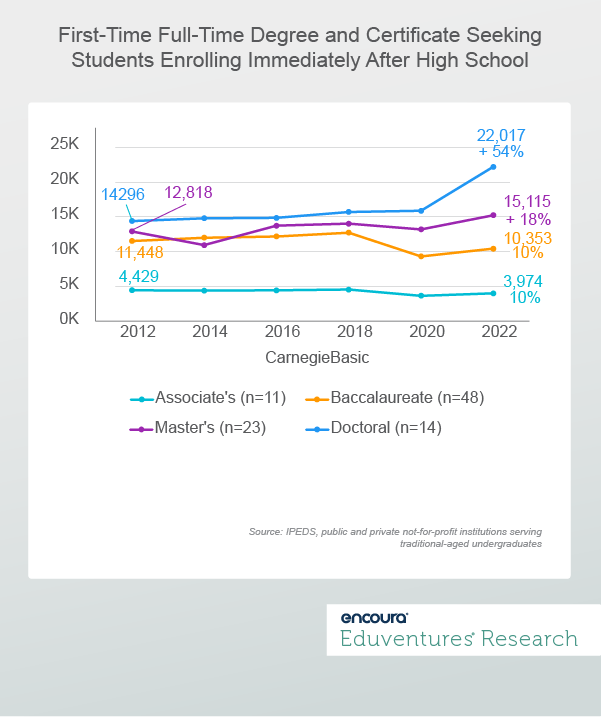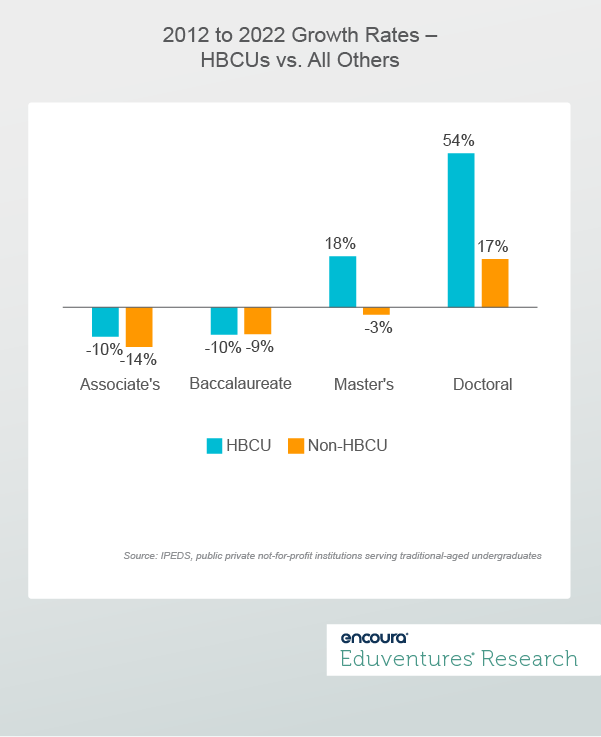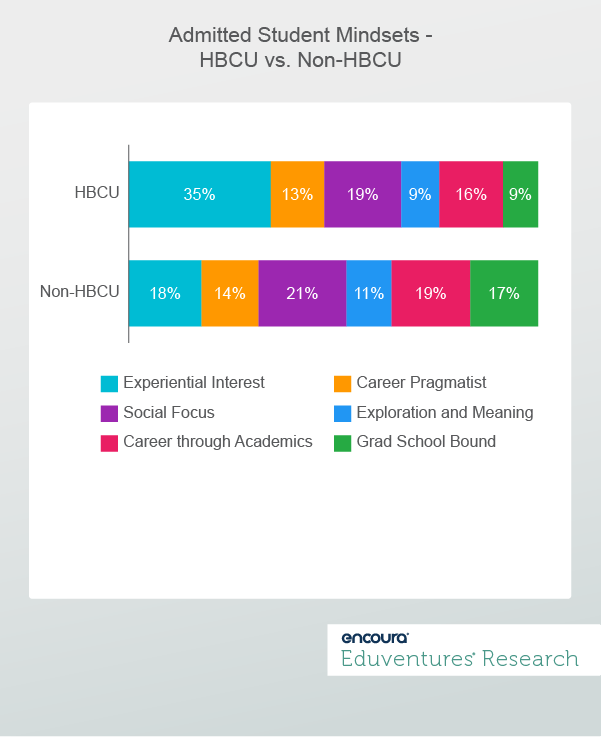The outlook for institutions seeking to enroll Black students has become far less certain—thanks, in large part, to the twin forces of the Supreme Court ruling on the use of race in admissions and the concomitant pullback of diversity, equity, and inclusion efforts among U.S. institutions. Add in COVID recovery and this year’s FAFSA snafu, and most institutions are concerned about their abilities to attract students who have been historically underserved.
But for Historically Black Colleges and Universities (HBCUs), this changing environment has been a boon.
HBCUs are a small but critical sector of the higher education landscape, making up 2% of all public and not-for-profit institutions serving traditional-aged students. On average, at non-HBCU institutions in the U.S., 11% of enrolled students identify as Black. At HBCUs, that mission-defining number is 77%. These are different worlds. And Black students are seeking out the HBCU world in increasing numbers.
Figure 1 shows that HBCU enrollment grew slowly from 2012 to 2018 with a 1% compound annual growth rate (CAGR). That growth has accelerated sharply post-COVID.
Figure 1.
HBCU’s are not immune to the forces we’ve seen in the market broadly. Most of the growth among HBCUs is occurring at the master’s (+18%) and doctoral (+54%) level institutions, while baccalaureate- (-10%) and associate-level (-10%) institutions are in decline. But Figure 2 shows that the rapid growth of master’s- and doctoral-level HBCUs is market-beating.
Figure 2.
This shows that in the broader market, master’s institutions are struggling (-3%) while HBCUs show rapid growth (18%). In the broader market, doctoral institutions show robust growth (17%) while HBCU’s show exceptional growth (54%). But what kind of student chooses an HBCU?
Eduventures’ Admitted Student Research™ shows that students who are interested in HBCUs are very likely to be from low-income families or be the first member of their immediate families to attend college. This is especially true among students interested in baccalaureate-level institutions, of whom 59% are low-income and 52% would be the first to attend college. By comparison, at non-HBCU institutions, 24% of prospective students are low-income and 27% would be the first in their families to attend college.
Figure 3 shows that we also find different Admitted Student Mindsets™ among HBCU-interested students compared to others.
Figure 3.
The top Admitted Student Mindsets among HBCU-interested students, of any race or ethnicity, is Experiential Interest—35% of these students fall into this Mindset vs. just 18% of students nationally! Social Focus (19%), and Career through Academics (16%) rank second and third. Compared to other students, HBCU-interested students are much less likely to be Grad School Bound (9% vs. 17%).
This indicates that resume-building opportunities that result in strong careers are critical for the HBCU-interested student, as are hands-on experiential opportunities. So too, the social milieu of the HBCU mission is to uplift, educate, and support Black students.
Students who choose to enroll at HBCUs often talk about a desire to balance a commitment to the educational mission and to their career goals:
“I wanted a college that would work with me and not against me, that was also cost efficient. Even though I wanted to travel out of state for college, this is close to home and still around the same price as home. Not to mention the many opportunities for scholarships.”
“Paul Quinn College has a very strong school of business, and I wanted to study under the best minds in the country. It also offered the specialization I was seeking, and I wanted to fast track my education.”
“I have chosen Clark Atlanta because I always wanted to go to an HBCU to be around people who look like me and also want to change the world for the better. I know that I will be comfortable and welcomed when coming in and will come out a strong Black woman.”
“I have chosen to attend Spelman College in hopes that it will teach me how to exist in a professional industry as the ‘other’.”
“I chose that school because the thought of being in a new scene and being around people who look like me and uplift me is exciting to me.”
The Bottom Line
The HBCU mission is a strong draw, but not a singular draw. Like all institutions, HBCUs must focus on the outcomes story—in particular, the Experiential Interest Mindset’s hands-on approach to career. A strong institutional narrative on outcomes is a powerful multiplier for the HBCU mission.
HBCUs must also underscore the many ways that an HBCU education can lead to a high-quality job and highlight their long-standing commitment to provide access at all levels.
And what can schools looking to attract or maintain Black enrollments learn from HBCUs?
Non-HBCUs must not only demonstrate academic strength and experiential outcomes, but also strongly countervail the perceived erosion of DEI. This will be challenging in the current policy environment. Nevertheless, students of color must see the evidence that they will find what they forgo at an HBCU: a community where they feel belonging and have the opportunity to flourish.




